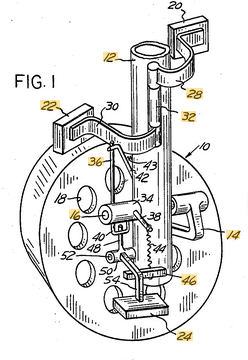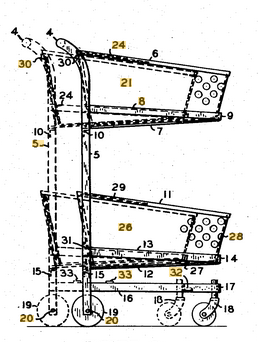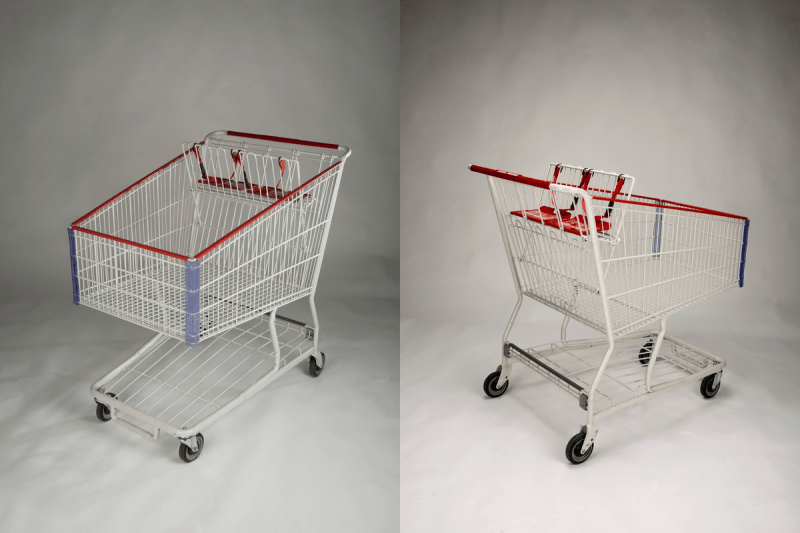
Shopping carts are surprisingly expensive. Prices range up to about $300 for a cart, which may seem like a lot, but they have to be pretty rugged and are made to work for decades. Plastic carts are cheaper, but not by much.
And carts have a way of vanishing. We’ve seen estimates that cart theft costs hundreds of millions of dollars worldwide annually. To stem the tide, stores sometimes pay a reward to people to round up carts off the street and return them to the store — it’s cheaper than buying a new one. That led [Elmer Isaacks] to patent a solution to this problem in 1968.
The [Isaacks] system used lots of magnets. A cart leaving the store had a brake that would be armed by running over a magnet. Customers were expected to follow a path surrounded by magnets to prevent the brake from engaging. If you left the track, a rod passing through the wheel locked it.
A third magnet would disarm the brake when you entered the store again. This is clever, but it has several problems. First, you have to insert magnets all over the place. Second, if someone knows how the system works, a simple magnet will hold the brake off no matter what.

There are some low-tech ways to stop theft, too. For example, if the store has barriers too narrow for the carts to pass, customers can’t leave the store. That’s not very nice if you are trying to get a week’s worth of stuff to your car. You sometimes see poles on carts rising taller than the door, to prevent the cart from leaving the building, which, of course, has the same problem.
Some stores, particularly Aldi, require a small deposit to get a cart. You get the deposit back when you return the cart. This not only discourages theft but also cuts down on having to hire kids to round up carts in the parking lot. The problem is that the deposit is usually a low-denomination coin, so if you really want to steal a $200 shopping cart, losing a quarter is probably not much of a deterrent.
Higher Tech
Building on the [Isaacks] solution, more modern systems use a perimeter fence — usually a wire, but sometimes magnets — that causes the brake to engage if you roll the cart over it.
This drives the cost up and is expensive to install. Worse, if you only have one wheel lock, a smart customer could lift that wheel off the ground and bypass the virtual fence. That means you probably want two locking wheels, although that still doesn’t preclude a strong thief or two thieves from carrying the cart over the line. You can see a breakdown of what’s happening in the Science Channel video below.
Smart cart locks can also help solve “pushout,” an industry term for people filling a cart and walking out without paying. A properly equipped cart can determine if it exits the store without going through a checkout line. This is probably error-prone and not foolproof, but it might stop many pushouts.
Where’s the Hack?
Many common carts use 7.8 kHz signals on the sensing wire. Since that’s within the range of audio, you can actually hack them pretty easily.
A DEFCON presentation shows how you can use your phone to lock and unlock shopping carts. Not that we suggest you do that. As [Joseph Gabay] notes: “I never really wanted a shopping cart, but…I have the knowledge that if I wanted a shopping cart, I could have one.” His video below shows many of the internal details of some of the common shopping cart systems.
Who Knew?
You’d think a shopping cart was about the simplest thing you’d deal with all day. But, like many things these days, it conceals some very high-tech electronics. And it seems like there should be some better options. Locking wheels might be fine when you have someone actually stealing, but if you ever have a cart lock up while you are moving quickly, it isn’t pleasant.
If you become super interested in shopping carts, the National Museum of American History has a section of shopping carts. Why not? People get obsessed with strange things. If the modern system seems familiar, maybe you are thinking of invisible doggie fences. If you want to hack a cart, you probably want to buy your own to start with.
Featured image: “Large Capacity Shopping Cart” from the National Museum of American History collection.
















“the store has barriers to narrow for the carts to pass” –> “too narrow for the carts to pass”
Thanks, and fixed.
and one of the images has a caption that mentions courts and paten
I’ve never seen a store in the UK that prevents shopping trolleys reaching the car park.
The £1 coin slot does most of the work of preventing theft,. If someone really wants a shopping trolley, they can steal one, but I’d bet at least 80% of theft is kids messing around, and the £1 makes it cost something, which is too much (plus means you actually have to come prepared with a £1 coin to do it… less common these days!).
The next biggest group will be people who want to push their stuff home (and don’t have a car and aren’t using the bus…)
They’re determined, though given they’re probably low income, that £1 is more meaningful. But also as the trolley is heavy (or they’d just carry it home in bags) lifting it over the security wire is hard.
Adding to that, narrow exits on footpaths mean that they’ve got to push it out the car exit, which is risky and very noticeable on CCTV.
So my guess is that whilst trivial to defeat, those measures cut the vast majority of thefts?
We had a German exchange student who brought (as a gift) a keyring that held a fancy little Euro-sized disk – Instead of putting a Euro in the cart, you’d put this is an grab it when you’re done. But we don’t have anything like that in the United States. I still have the thing somewhere… I wonder if I’ll remember to bring it along when I get back across the pond.
Just 3D print them.
I have a double sided $1 and 25 cent.
So I don’t need to look for coins.
If you go as far as printing it, do it with the version you can wiggle out: to not let your keys hanging, proper hacker way.
Use it at Aldi’s if the size is right (the US one use 2 quarters I think?)
The edge of some shop car parks do trigger breaks though. A few have it clearly labelled too. Could be a deterrent I suppose.
It’s so tempting to build one of those signal generators into a wand so I can run around stores tapping shopping carts and cackling “spell of holding; roll 4 or less on d20 to escape”.
Hahahaha, extra damage if you dress as a wizard
In the US the response would be, “I only roll with my .40 (AKA the “Problem Solver”).
Coins are there to discourage common people from abandoning carts far away from their appropriate places; a thieve wouldn’t care.
Also they’re easy to fool; my hardware store sells washers of the right size to fool its own cart slots, and it works with almost all discounts around. I carry and use almost always that washer instead of coins not because I misplace carts but because I often realize I ran out of coins when I’m right there to take one.
I don’t think anyone where I live ever actually wants a shopping cart – I expect there are two groups: Students who are drunk late at night take a shopping cart, ride around in it, and then throw it into the canal. Or people who live in walking distance of the store, who use the cart to bring their shopping home and then abandon the cart somewhere outside. Or throw it into the canal.
“Throw it in the canal” is the problem. Our neighborhood flooded after just a moderate rain. Water damage to many houses. The county investigated and ended up removing almost 200 carts from the canal. This was along a path thru the woods leading to a low-income neighborhood. They would push the cart with their groceries as far as the canal, but then couldn’t get it across the narrow foot bridge so they simply pushed it in the water.
A few years later it happened again. And a few years later, yet again. They county ended up installing a bridge that you could get a shopping cart across.
a deep shopping cart is just the right size to fit a small keg and cooler/tap, all while allowing high mobility through the whole dormitory…was also pretty useful for wheeling stuff from the car park to the rooms and back
Oh man you aren’t even close to the actual demographic. I wonder why you can’t see the obvious
In California, it’s the homeless that take/ use shopping carts outside the store to move their stuff around town.
Have you suggested to them that they try not being homeless?
Then they finally can do some homeshopping! /s
Yeah maybe they should get off fent and get a job
Whoosh in a standard American right wing heartless way.
I’ve definitely been on the sad receiving end of a shopping cart wheel lock inexplicably lock up in the middle of the store. It’s like running into a steel bar right at waist height at full walking speed. Unfun, zero stars, do it recommend.
I remember the first time I saw one of these I was so fascinated I parked my car to try and test out the locking mechanism. It didn’t work, and I was pretty disappointed.
Fast forward about 10 years and my local supermarket installed them. I had the cart break activate while I was headed toward the door with the goods I’d purchased. I had to wait until someone could come unlock it. It had the strong feeling of legitimate users being hampered by DRM…
brake
Alternatively delete ‘activate’ and then both work
“It had the strong feeling of legitimate users being hampered by DRM…”
Most packaging for items. And yes, it happens a lot. I currently have to take a package back because a shoplifter cunningly cut open and removed the item. Neither me nor cashier noticed.
Here in the Netherlands pretty much any store requires a coin. Often the stores even hand out dummy coins when asked, aka the german exchabge studebt story from above.
During covid most stores allowed for coinless use, by taping the slot or some such. Some stores (hornbach for example) kept them coinless, all others returned to the old ways.
This all probably for exactly the reason of theft. Damn kids and their ‘jokes’ … ot maybe its the returning thing? I have a metal dummy coin on my key chain that I can easily pull out after unlocking the cart …
My local supermarket abolished coins during covid but now randomly has weeks where all carts are locked, and then they are all unlocked again… But this is the locked-with-chain-to-previous-cart. I don’t think they have a wheel lock.
I push about two carts per month back to the store – even if they are from other stores – the municipality will collect random bigger trash, but not shoppimg carts (“that’s the responsibility of the supermarkets”) but most supermarkets don’t have a digital contact method to report those. There was a website where you could report them, but apparently they were volunteers and closed down rwo years ago after 17 years.
I find an overturned shopping cart is +10 ghetto points for your neighbourhood…
Good for you. If you’re going there anyway, why not? I try to pick up at least one piece of litter whenever I walk somewhere. If everyone else did the same, there wold be no litter.
Hmm I wonder what else might be different in the Netherlands
Well, they speak Dutch for a start.
Most carts now get flat spots from being pushed with the brake on and make for a bumpy shopping experience. I have wondered if the magnets attract iron debris that will stick in tires point up because of the field.
Our local Kroger had them for a while, problem is they used half their (already tiny) parking lot for a gas station and a Starbucks so you usually have to park half way down the shopping center (which is one of many reasons I rarely go there) and the wheels would lock in the middle of the parking lot… SO there were a lot of bricked carts sitting in the middle of the lanes
The carts are never cleaned. There should be studies on the amount of bacteria and other dirt carried by these infernal machines. Especially for the plastic carts.
When you go to the checkout you have to bend down to pick up the goods at the bottom: it’s very bad for your back health.
The worst are the families who put their kids in there with their dirty shoes and even teenagers glued to their smartphones who completely fill the thing, people who never wash their hands that they put on the bar, elderly or not so elderly people who use them like walkers and it’s like being in a retirement home.
I only use a sturdy personal bag that I carry with my hands or a backpack – it forces me to go shopping more frequently, but I go there most of the time by bike to get exercise. On the other hand, I only buy what is necessary, no useless junk, and it takes much less time than pushing a slow cart (I’m pretty sure they do this on purpose). I don’t think I’m an isolated case, I’ve noticed that many people do the same.
So frankly, if carts are stolen, I won’t raise an eyebrow !
(that was my evening therapy ;-)
Every store I go to has sanitizing wipes right there at the front for the purpose of the shopper so desires. But food in you for not just moaning about it but instead taking it in a positive direction for your own health (backpack, frequent non-car trips etc)
At one point I was commuting by bike daily and had a store on the way home. I went “shopping” regularly buying what I needed for the day and it took like 5 minutes. As a super bonus our fridge was never gross and over stuffed with old food and the counters and cupboards were pretty sparse and clean.
You do bring an interesting point, most people aren’t aware of the psychological engineering aspect of shopping carts, and the design of the store layout. I have had it work on me a few times. Note large grocery outlets funneling you past questionable deals. I don’t even look at anything down that first ‘aisle’. I go in looking to buy my usual products, and if I feel like getting a bargain I look for the actual clearance section. And I don’t buy that if the store 2 blocks away has the same for less every day.
I trained as a Target employee when I worked there in college, they had a creepy indoctrination course of 8 hours or more (I feel it was more than a single day), the HR supervisor even explained that the store was ‘designed to make women feel comfortable and let go if their children’s hands so they can shop freely”. Also the layout was particularly curated to encourage purchases from their target market. Can confirm, found a family friend’s child dancing from front to back in the store one day.
The unloaded and stocked starting at 3AM, and the bizarre ‘alien/stepford wives’ expressions on the full size cutouts were doubly creepy at that hour. It was an ‘interesting’ experience. Target is the place to go for home decor/organization if you aren’t near an IKEA though, they are well stocked with cube based storage, 2 aisles worth at the stores near me.
Wheel locks so far are not used where I live. Only ALDI implements any sort of anti theft. The carts are chained together with a mechanical lock that requires a quarter to unlock. You get your quarter back when you reattach the chain to another cart.
Hence the joke “If you want a shopping cart they only cost 25c at ALDI.”
It’s the same here for all supermarkets.
In case you don’t have the required coin you can ask for a plastic token at the store reception.
The main interest of the chain/coin system is to avoid customers leaving the carts anywhere and having to pay staff to group them, more than to avoid theft except perhaps in some urban areas.
Maybe people should look into why this is needed in some areas and not others. I wonder what might be revealed
I hear the RF wheel locks react to a signal that’s easily picked up with an old telephone pickup plugged in to an mp3 player, and easily reproduced by a coil of wire in a belt made of an old db9 serial cable plugged in to said mp3 player at max volume. I’ve heard it has a range of 8 feet or so. Or so I hear…
The electric carts for mobility limited people, are a hoot when they shut off while near the storage area doors.
Shopping carts don’t “vanish”. They are moved to the grassy area behind the storage facility near my shop.
Shopping carts don’t “vanish,” Bubbles from Trailer Park Boys fishes them out of the gully and then fixes them up. It’s a living
Half unbend a solid papper clip and insert it in the other hole (where you put the chain) and you get back the coin. Old trick always works.
These are the bane of my existence. The wheel is softer than the others, presumably to provide more grip when it brakes to make it effective.
All the wheels at my local members outlet have flat spots, leading to nasty vibrations when pushing.
I can only assume they are pushed or pulled after the wheel locks up. Not sure if it is customers or employees doing that.
Regardless it’s a bad experience. 2/10
Will we end up needing to use Apple Pay just to use a cart? Picture this: Tap to deposit $5 for use of the cart. Once you’re done, return it to the designated area. A small fee will be deducted, and you’ll get back $4.50.
I doubt supermarkets save much by implementing these systems. Seems like security theater for the customers and clueless CEOs.
The local supermarkets have wires buried in the pavement around the perimeter of the property in a continuous loop that is energized with a signal that activates the brake when the wheel passes over it. To unlock the wheel requires a device that looks like an oversized cellphone. One local store decided to add smaller carts to its inventory. They lasted 5 days. Nobody checked to see if the wire loop in the pavement actually works. A break in the wire completely disabled the system. Talking to the manager I found out they started with 150 carts. He told me it was a test of the newer carts. Smaller carts means more carts for more shoppers to use. He then stated that at least the homeless are happy, they have brand new carts to use! They fixed the system, but abandoned the idea of smaller carts.
A few weeks later I was chatting with a woman behind me while cued up for the cashier. She mentioned that she would park the cart before the wire and her children (8 year old boy, 11 year old girl) would stay with the cart as she made several trips to her condominium across the street. When I went outside, I waited for her. When she approached I offered to help her. I lifted the front of the cart about 18 inches (45cm), carried it past the wire, and set it down. She was happy to be able to hack the system and said she would return the cart.
Another market surrounded by senior citizen apartments doesn’t use anti-theft devices. They have an employee go out in the mornings to several apartment buildings with a battery powered machine that pushes the carts and rounds them up as a courtesy for the old farts.😎